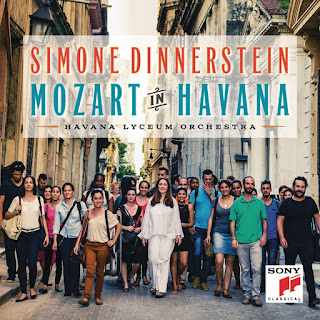 Sony Classical will release acclaimed pianist Simone Dinnerstein's new album, Mozart in Havana,
on April 21. The new album, recorded in Cuba, may be her most ambitious
to date and is a testament to music's ability to cross all cultural and
language barriers. For it, Dinnerstein has collaborated with the
virtuosic Havana Lyceum Orchestra to perform Mozart's
Piano Concerto Nos. 21 and 23. In June, the Orchestra will also make
their American debut in a series of concerts, the first time an
orchestra of this size has traveled to the U.S. from Cuba since the
revolution.
Sony Classical will release acclaimed pianist Simone Dinnerstein's new album, Mozart in Havana,
on April 21. The new album, recorded in Cuba, may be her most ambitious
to date and is a testament to music's ability to cross all cultural and
language barriers. For it, Dinnerstein has collaborated with the
virtuosic Havana Lyceum Orchestra to perform Mozart's
Piano Concerto Nos. 21 and 23. In June, the Orchestra will also make
their American debut in a series of concerts, the first time an
orchestra of this size has traveled to the U.S. from Cuba since the
revolution.
In one sense, Mozart in Havana is a return to Dinnerstein's origins as a musician. Her connection with Cuba started early with Solomon Mikowsky,
a Cuban émigré who became her piano teacher when she was nine. Mikowsky
would tell stories of his childhood in Cuba and the country's many
musical influences. Dinnerstein recalls, "I learned so much from
Solomon, and one thing was that a musical culture is not something you
have to be born to but something you can choose."
Over the last several decades, Mikowsky became an advocate of Cuba's
rich culture and arts landscape. When he inaugurated the Encuentro de
Jóvenes Pianistas (Meeting of Young Pianists) festival in Havana in
2013, he invited Dinnerstein to play. "Of course I accepted without
hesitation and Havana turned out to be everything he had told me it
would be," Dinnerstein explains, "a city profoundly different from any
other I knew, with warm appreciative audiences who had a deep engagement
with music."
Dinnerstein returned to the festival in 2015, this time to play a
Mozart concerto with the Havana Lyceum Orchestra. Not knowing what to
expect, she was deeply impressed. "They played with thoughtful
sensitivity and sensual beauty, despite the fact that in some cases the
materials they were using were inferior. It was clear that the sound
they made came from inside them, not simply from their instruments."
Within a year she had returned to Havana's Oratorio San Felipe Neri to record with the Orchestra what would become Mozart in Havana.
The recording was done over three long, sleepless nights using donated
strings and recording equipment brought in by Grammy Award-winning
producer Adam Abeshouse. His peerless expertise helped
navigate the various challenges of the late-night city soundscape
including stray dogs barking, a neighbor jackhammering on his roof and
sparrows rustling in the eaves of the building.




No hay comentarios:
Publicar un comentario